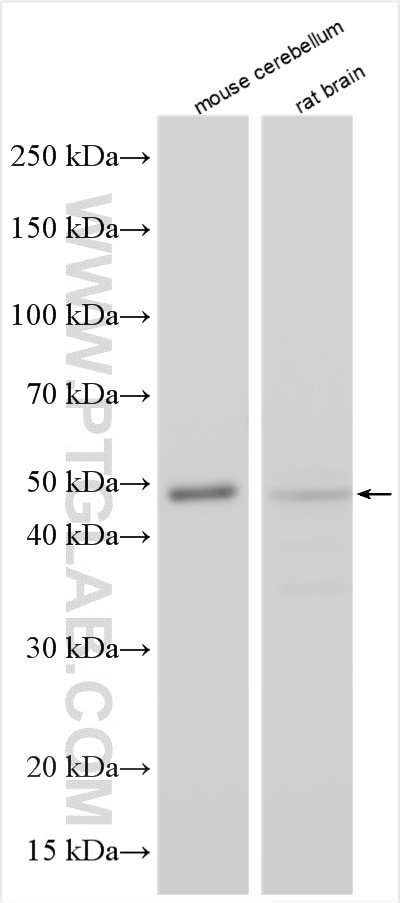Tested Applications
| Positive WB detected in | mouse cerebellum tissue, rat brain tissue |
Recommended dilution
| Application | Dilution |
|---|---|
| Western Blot (WB) | WB : 1:500-1:2000 |
| It is recommended that this reagent should be titrated in each testing system to obtain optimal results. | |
| Sample-dependent, Check data in validation data gallery. | |
Product Information
28335-1-AP targets GFRAL in WB, ELISA applications and shows reactivity with human, mouse, rat samples.
| Tested Reactivity | human, mouse, rat |
| Host / Isotype | Rabbit / IgG |
| Class | Polyclonal |
| Type | Antibody |
| Immunogen | GFRAL fusion protein Ag28504 Predict reactive species |
| Full Name | GDNF family receptor alpha like |
| Calculated Molecular Weight | 45 aa, 85 kDa |
| Observed Molecular Weight | 45-60 kDa |
| GenBank Accession Number | NM_207410 |
| Gene Symbol | GFRAL |
| Gene ID (NCBI) | 389400 |
| RRID | AB_3669653 |
| Conjugate | Unconjugated |
| Form | Liquid |
| Purification Method | Antigen affinity purification |
| Storage Buffer | PBS with 0.02% sodium azide and 50% glycerol , pH 7.3 |
| Storage Conditions | Store at -20°C. Stable for one year after shipment. Aliquoting is unnecessary for -20oC storage. 20ul sizes contain 0.1% BSA. |
Background Information
GFRAL (GDNF family receptor alpha-like), also called C6orf144, is the brainstem-restricted receptor for GDF15 hormone, which triggers an aversive response, characterized by nausea, vomiting, and/or loss of appetite in response to various stresses (PMID: 28846097, 28846098, 28846099, 28953886, 36630958). The GDF15-GFRAL signal induces expression of genes involved in metabolism, such as lipid metabolism in adipose tissues (PMID: 32661391). GFRAL is a single-pass membrane protein, and localizes to the plasma membrane. It is mainly expressed in the hindbrain, and its mainstream molecular weight is 45-60 kd.
Protocols
| Product Specific Protocols | |
|---|---|
| WB protocol for GFRAL antibody 28335-1-AP | Download protocol |
| Standard Protocols | |
|---|---|
| Click here to view our Standard Protocols |



